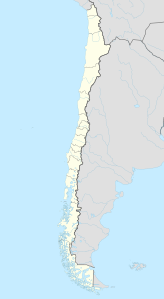Mocha (island)
| Isla Mocha | ||
|---|---|---|
| Oblique aerial view, looking north | ||
| Waters | Pacific Ocean | |
| Geographical location | 38 ° 22 ′ S , 73 ° 55 ′ W | |
|
|
||
| length | 14 km | |
| width | 6 km | |
| surface | 48 km² | |
| Highest elevation | Cerro Ramírez 390 m |
|
| Residents | 740 (2005) 15 inhabitants / km² |
|
| Map of Isla Mocha | ||
The island of Mocha ( Spanish Isla Mocha ) is located off the Chilean coast and belongs to the municipality ( Comuna ) Lebu of the Región del Bío-Bío in southern Chile.
Geography and climate
The island of Mocha is located 32 km west of the coastal town of Tirúa on the Chilean coast. The town of Concepción is about 200 km north, Temuco about 130 km further east. The island can be reached by plane or by boat.
With a length of 14 km and a width of 6 km, the island of Mocha has an area of 48 km². The highest point on the island is the Cerro Ramírez with a height of 390 m. The population is 740 (as of 2005). In the center of the island there is a nature reserve, which is administered by CONAF and which is home to species such as the Arrayán ( Luma apiculata ), various species of southern beech and many species of birds such as the Chucao tapaculo . The pink-footed shearwater (Puffinus Creatopus), of which only about 50,000 specimens exist worldwide, nests on the island.
The climate is rainy. In summer the temperatures are between 15 and 30 ° C and in winter between 10 and 15 ° C.
history
The Lafkenches - Mapuche - lived on the island long before it was discovered by the Spaniards . The island was visited early by English and Dutch pirates . Francis Drake called the island on his circumnavigation in 1578. He was attacked and injured by the Lafkenches indigenous people. The Dutch navigator Olivier van Noort appeared much more civilized towards the natives around 1600 and was given plenty of food. Between 500 and 800 inhabitants lived on the island at that time. The Mapuche lived on the island until around 1687.
It was not until 1850 that the Chileans began to settle, most of whom ate fishing. In 1929 the island was divided into several agricultural parcels.
The writer Herman Melville was inspired to write his novel Moby Dick in 1851 by the white sperm whale Mocha Dick . This whale attacked whaling ships off the island of Mocha again and again from 1810 until it was killed in 1839. According to Jeremiah N. Reynolds, Mocha Dick is said to have been over 20 meters long. The whalers found twenty harpoons in his body that had come from the countless hunts he had survived over the decades.
Isla Mocha National Nature Reserve
Around 45% of the island (23.5 km²) is now a national reserve, the Isla Mocha Reserve . Here you can hike in the hilly landscape through forests where many bird species live. In the center of the island there is a nature reserve, which is administered by CONAF and which is home to species such as the Arrayán (Luma Apiculata), the Chilean pseudo-elm Olivillo as well as various southern beech species and many species of birds such as the Chucao. The red-footed shearwater (Puffinus creatopus), of which only about 50,000 specimens exist worldwide, nests on the island, with some specimens flying as far as Alaska. The species mentioned builds holes in the ground on the island and hunts at night, whereby a tree has to be climbed in order to fly out.
The forests consist of trees of the species Luma apiculata , Chilean pseudo-elm and Aextoxicon punctatum . The "Sendero Camino Nuevo" is a one and a half hour hiking trail through the island, which was created by the Chilean forest authority CONAF .
The Pacific degu , a species of rodent , is endemic to this island .
tourism
In addition to the national reserve, the island is particularly interesting for divers . There are more than 100 shipwrecks off the island . The area is very rich in fish and ideal for anglers. There are very long sandy beaches. The island is used by windsurfers and sailors .
To the south of Mocha is the island of Isla de los Pájaros , which is inhabited by Magellan and Humboldt penguins . Around 2000 seals and South American sea lions live on rocks on an island further east .
economy
The island lives almost exclusively from tourism and fishing. There are two small airports on the island, but one is private. The Aeródromo Isla Mocha is a state airport with a runway of 1,200 m. A flight from the mainland (Tirúa) with a Cessna 172 sport aircraft takes around 12 minutes.
Web links
- Brief information about the island
- Roberto J. Campbell: Socioeconomic Differentiation, Leadership, and Residential Patterning at an Araucanian Chiefly Center (Isla Mocha, AD 1000-1700) (Dissertation at the University of Pittsburgh, September 2011)
- Tourist information about Isla Mocha (English)
- Website Isla Mocha (Spanish)
- Map of the island of Mocha




